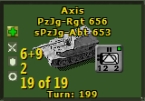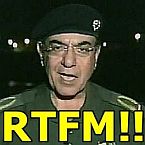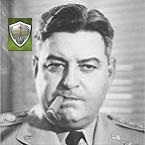vahauser
Posts: 1644
Joined: 10/1/2002
From: Texas
Status: offline

|
quote:
ORIGINAL: sPzAbt653
quote:
...the Movement Rates of the security units are still too high.
We changed them to 17-18 instead of 15-16 as most of them are out of the scenario early on, by turn 65. I reason that they would have had slightly better mobility early in the campaign than that of units in the later stages.
On some other points, I see we are getting some confusion between 'historical' and 'historical simulation'. So to clarify one point, the units in the scenario with the Divisional HQ icon are historical simulations of artillery, command and control, and supply assets. Where they operate and what they do should not be confused with the same attributes of an historical division headquarters.
quote:
...and incidentally, on the average and over the long haul, thirty km a day was an excellent pace for a first-line leg infantry unit to maintain. I mention this because most scenarios I see have infantry movement rates far in excess of that. What this scenario has I don't know.
If a typical infantry unit has 17 movement points, and it moves along a road under optimal conditions, it could move 48.5 km per day.
My concern over the security units is that they had no significant motorization. Rev-1 gives security regiments 10 wagons and 10 trucks. From a 'historical realism' perspective, that should be 18 wagons and 2 trucks (or 20 wagons and 0 trucks). With 18 wagons and 2 trucks, the regiment has a MR of 16. No argument from me if security regiments have MRs of 16 or less. Further, stripping the trucks out of the security units and giving all those trucks to the MP battalions is historically justifiable (having fully-motorized MP battalions is historically justifiable).
My concern over the 'historical simulation' is that it is not simulating history. By stripping out the artillery from the German infantry divisions, you are giving the players the ability to abuse the TOAW game system. Directive 21 should not reward players for abusing the TOAW game system.
Also, to address Colin's concern over 'leg' MRs. The base 'leg' MR is 14 (just foot infantry with no transport/hvy weapons). A MR of 14 can move a maximum of 14 hexes (140km) along friendly rear-area roads per half-week turn. Advancing into enemy territory cuts that to 70km per 3.5 days. A MR of 17 (which is what Directive 21 rates the German infantry) raises those numbers to 170km 'rear-area' movment and 80km 'combat' movement per 3.5 days. Of course, practically speaking in game terms, heavy marching will quickly degrade a unit's readiness and supply, thus quickly lowering its effective MR. As of now (the start of the playtest), I don't have any major worries regarding the MRs of German infantry, jagers, and gebirgsjagers. I think that the kavalrie MRs are a bit too high (I think 26 is more historically reasonable than 28), and I have worries about many many many other units' MRs, but establishing a 'benchmark' MR of 17 for the German infantry allows a good cross-reference point for all other non-motorized units to be compared to. I, for one, am satisfied today with the German infantry, jager, and gebirgsjager MRs.
_____________________________
|
 Printable Version
Printable Version













 New Messages
New Messages No New Messages
No New Messages Hot Topic w/ New Messages
Hot Topic w/ New Messages Hot Topic w/o New Messages
Hot Topic w/o New Messages Locked w/ New Messages
Locked w/ New Messages Locked w/o New Messages
Locked w/o New Messages Post New Thread
Post New Thread